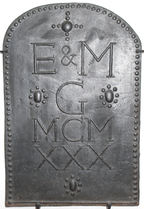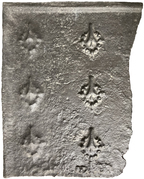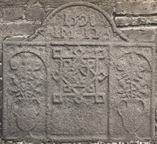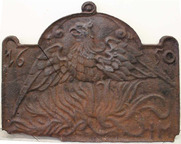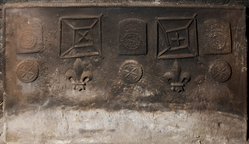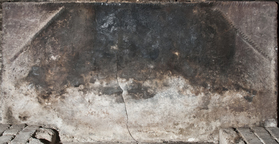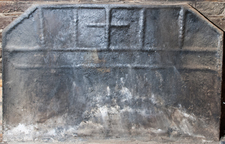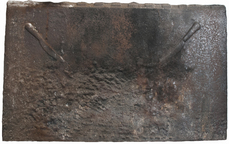-
774
Description: Arched shape with bead edging; from top, large bead with four pairs of small beads in a cross shape, text with pellet surrounded by eight beads on each side of 'G', and at bottom.
Notes: Made by, and bearing the initials of Eric Gill and his wife, Mary, in 1930.
Inscription: E&M / G / MCM / XXX
- Decoration tags:
- rounded arched (shape)
- bead (edging)
- whole carved pattern
- text
Manufactured: in 1930 at Loosley Row Foundry possibly in the Chilterns area of England.
Current location: Victoria & Albert Museum, Cromwell Road, Kensington & Chelsea, Greater London, England.
Museum number: M.4-1983 (part of the Victoria & Albert Museum museum group)
- Attached to series:
- Personal firebacks
- Date & initials firebacks
-
775
Description: Arched rectangle; ovol-moulded edging; pictorial scene of a begowned figure waving to figures standing beneath a portico with a sun behind, other figures opening a door to his left, above which is the shape of the man in the moon; blottom left, a computer; bottom right, a painter's palette.
Notes: A farewell gift to William Vaughan, Reader in Art History at University College, London (later professor of the History of Art at Birkbeck College).
Inscription: WILLIAM VAUGHAN / 1972 UNIVERSITY 1986 / COLLEGE
- Decoration tags:
- rectangular with round arch (shape)
- ovolo (edging)
- whole carved pattern
- pictorial
- architectural
- text
- humans
Manufactured: in 1987 in England.
Current location: Victoria & Albert Museum, Cromwell Road, Kensington & Chelsea, Greater London, England.
Museum number: M.15-1994 (part of the Victoria & Albert Museum museum group)
- Attached to series:
- Personal firebacks
-
1067
Description: Fragment; rectangular shape; ovolo-moulded edging (top and sides); six stamps, in two columns of three, taking the form of a long-pointed arrow head within a circlet of small curls.
Notes: The stamps are of an unfamiliar type with some similarity to the heraldic symbol for ermine. Because only the left part of the fireback has survived it is not known how many original columns of this stamp there were.
- Decoration tags:
- rectangular (shape)
- ovolo (edging)
- carved stamps
- heraldic
Manufactured: in the 16th century possibly in the Weald area of England.
Current location: Victoria and Albert Museum, Cromwell Road, Kensington and Chelsea, London, England.
Museum number: M.148-1915 (part of the Victoria & Albert Museum museum group)
- Attached to series:
- Miscellaneous stamp firebacks
-
1063
Description: Composite of three elements; central panel has a complex ‘knot’ pattern with a fillet edge; side panel, repeated on either side of the central panel, contains a vase of flowers, possibly stylised thistles, within an arched frame and fillet edge; arched panel above, also with fillet edge, contains the date and inscription; the spandrels of the side panels, and the arched top panel, contain a series of circular motifs comprising concentric rings deepening towards the centre.
Notes: ‘Knot’ patterns were popular in gardens of the period. The garden theme is continued with the side panels. An example of the same design, noted at Linchmere, West Sussex, is a different casting, the top panel with the date and initials being slightly askew. From a photograph in the Victoria and Albert Museum, London; photographed at Mapesbury House, Willesden in 1904.
Copies of this fireback are known.
Inscription: 1598 / IM IB
- Decoration tags:
- rectangular with round arch (shape)
- astragal (edging)
- carved pattern panels
- text
- plants
- objects
Manufactured: in 1598 in the Weald area of England.
Current location: not known.
Museum number: E.4376-2000 (part of the Victoria & Albert Museum museum group)
- Attached to series:
- Armada series
- Garden design types
-
895
Description: Quasi-arched rectangular shape, semi-circular protrusions on top corners; cavetto-moulded edging looped at top; two mirrored scrolls inside arch; a phoenix in flames, its wings displayed and inverted; date, in two parts, in top corners; initials in bottom right corner.
Notes: On a copy (no. 590) the loop at the top is missing and the date and the initials have been erased.
Copies of this fireback are known.
Inscription: 16 50 / IM
- Decoration tags:
- rectangular with round arch (shape)
- cavetto (edging)
- whole carved pattern
- pictorial
- mythological
- text
- animals
Manufactured: in 1650 possibly at Brede Furnace in the Weald area of England.
Current location: not known.
- Attached to series:
- Hooked '1' series
- IM series
- Loop edged firebacks
- Brede group
- Phoenix firebacks
-
1276
Description: Rectangular shape; twisted rope edging (top and sides only); along the top, two irregular arrangements of rope lengths forming a small quasi-square within a larger quasi-square, with the outer corners of the small square joined to the inner corners of the larger square, a short length of rope extending outwards from the top and bottom right corners of the larger square, and within the left small square a rope saltire, and in the right small square a rope cross; between and outside of these rope arrangements, an arched rectangular stamp, with indented edges, of a crowned rose-en-soleil impressed three times; below each rope pattern a fleur-de-lys; below each rose-en-soleil stamp, a circular, six-pointed-star-embossed stamp with beaded edging.
Notes: All of the stamps have been noted on a series of other firebacks together with variations of the rope arrangement. The clarity of the condition of the stamps suggests that this casting predates the others in the series.
- Decoration tags:
- rectangular (shape)
- rope (edging)
- simple stamps
- carved stamps
- heraldic
- royal
- objects
Manufactured: in the mid- to late-16th century possibly at Pounsley Furnace, Framfield in the Weald area of England.
Current location: in private hands, Wadhurst, East Sussex, England.
- Attached to series:
- Pounsley series
- Rose-en-soleil series
- Food mould stamp firebacks
-
1277
Description: Rectangular; twisted rope edging (top and sides only); rope diagonally length across each top corner.
Notes: A very simple rope design seen in several variations on other firebacks.
- Decoration tags:
- rectangular (shape)
- rope (edging)
- simple stamps
Manufactured: in the late-16th to early-17th century in the Weald area of England.
Current location: in private hands, Wadhurst, East Sussex, England.
- Attached to series:
- Rope design firebacks
-
1278
Description: Canted rectangular shape; twisted rope edging (top and sides only; two approximately parallel horizontal lines of twisted rope across the upper centre; from the upper line and starting at the top corners, five regularly-spaced vertical lines of twisted rope extending to the top edge, the centre one with a horizontal rope length formiong a cross.
Notes: A simple rope design with apotropaic significance.
- Decoration tags:
- rectangular with canted top corners (shape)
- rope (edging)
- simple stamps
- apotropaic
- objects
Manufactured: in the mid- to late-16th century possibly in the Weald area of England.
Current location: in private hands, Wadhurst, East Sussex, England.
- Attached to series:
- Rope design firebacks
-
1279
Description: Plain rectangular shape with chamfered and embattled top edge; impression of a utilitarian, domestic knife inclined, blade down, at an angle of about 45 degrees from inside the top corners; the knife measures about 20.5cm in length.
Notes: An unusual, if not unique, top edge. The form of the knife suggests a late-16th or early-17th century date. The uneven surface of the lower part of the fireback may have been caused by the pouring of the molten metal and the consequent disturbance of the casting sand of the mould.
- Decoration tags:
- rectangular (shape)
- none (edging)
- simple stamps
- objects
Manufactured: in the late-16th to early-17th century in the Weald area of England.
Current location: in private hands, Wadhurst, East Sussex, England.
-
1280
Description: Canted rectangular shape; twisted rope edging (top and sides); two approximately parallel horizontal lines of twisted rope across the upper centre; from the upper line and starting at the top corners, seven regularly spaced vertical lines of twisted rope extending to the top edge.
Notes: A simple rope design without apotropaic significance.
Copies of this fireback are known.
- Decoration tags:
- rectangular with canted top corners (shape)
- rope (edging)
- simple stamps
- objects
Manufactured: in the late-16th to early-17th century possibly in the Weald area of England.
Current location: in private hands, Wadhurst, East Sussex, England.
- Attached to series:
- Rope design firebacks
